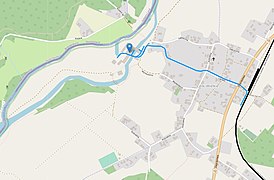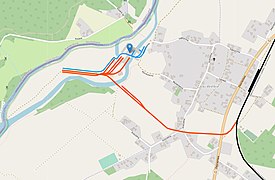Cardboard paper mills Groß Särchen
| Cardboard paper mills Groß Särchen
|
|
|---|---|
| legal form | Corporation |
| founding | 1895 |
| resolution | 1945 |
| Seat | Groß Särchen in the Neißetal, Germany (now Żarki Wielkie in Poland) |
| management |
|
| Number of employees | 430 (1928) |
| sales | 2.65 million RM ( gross profit 1939) |
| Branch | Paper industry |
The Kartonpapierfabriken AG Groß Särchen (KAPAG) was a factory for the production of cardboard and fiberboard in Groß Särchen, east of the Lusatian Neisse in the Sorau district . The place called Żarki Wielkie has been in Poland since 1945 .
Company history
Beginning
The cardboard factory was built from 1885 next to a grinding mill owned by the merchants and mill owners Brade and Noack. The grinding mill was destroyed by a major fire in 1896 and then completely abandoned in favor of the cardboard factory. It was initially called Groß-Särchener Holzstoff- und Lederpappenfabriken Kunstmühlen AG, formerly Noack & Brade, and produced machine leather board, gray, pull-out, folding box, chromo replacement and machine wood cardboard . The company name was changed to Norddeutsche Lederpappenfabriken AG in 1900 . In 1904, the Ferdinand Falch roofing felt factory in Brieg was bought by Cosel together with a wood grinding shop in Lenartowitz (now Lenartowice) . In 1912 another branch was acquired with the Keferstein paper mill in Sinsleben and in 1922 the wood grinding shop in Lenartowitz was sold again.
KAPAG
The company was given its final name, Kartonpappenfabriken AG Groß Särchen ( Sorau district ) (KAPAG), in 1923. The branch factory in Sinsleben was shut down and closed in 1924, and some machines were re-erected in Groß Särchen, some after renovation. The other systems in Sinsleben were sold until 1931.
On the sixth Jahresschau German working in Dresden, in 1927 under the motto The paper was that KAPAG showed the usefulness of their developed for years Baudoppelwelle as a substitute for wood and brick construction. Among other things, KAPAG built the Viktoria-Haus based on designs by the architect Heinrich (Heinz) Wichmann . The so-called paper house had a built-up area of more than 500 m², was clad with the construction double wave and partly plastered. It served as a restaurant for visitors to the annual exhibition.
For the daily production of around 100 t of cardboard, four wood pulp digesters , three cardboard paper machines, brown wood and white grinders and wood pulp processing systems were available. Around 1930, the main plant in Groß Särchen included, in addition to the administration building, a workers ' welfare building, eight residential buildings for executives with 17 apartments and seven workers' houses with 44 apartments.
From 1932 wood fiber boards were produced, the production of which was expanded considerably in the following years. The so-called KAPAG hardboards, manufactured according to the defibrator method patented in 1932 by Arne JA Asplund (1903–1993), were used in many ways as insulation and insulation panels in the construction industry and were a real alternative to masonite manufactured using the Mason method Plates from Sweden and the USA. In 1936 the sewage treatment plant was expanded. In addition, eight new twin houses were built for the workforce between 1935 and 1939. In 1940 more than 80 company apartments were available.
In 1940 the production volume of KAPAG insulation and KAPAG hard boards was around 7000 m² per day. In 1943 the branch in Brzeg was sold again. Most recently, the majority of the shares lay with the Margarine -verkauf -Union , which also established its director Ferdinand Schraud as chairman of the KAPAG supervisory board.
The End
The plant was completely dismantled after 1945 and later partially used as a granary. It is now in ruins. Only a new, hydroelectric power station is in operation on the former site. The hydropower plant works with two 1800 mm Kaplan turbines of 320 kW each. It is located on a canal with a total length of 1100 m. The weir was rebuilt in 1959 after being destroyed in the war. It has three flat two-piece gate valves. After the modernization of the underwater part, the power plant was put back into operation in 1966 and currently (as of 2020) belongs to Polska Grupa Energetyczna (PGE).
power supply
After a weir breach in the main works in Groß Särchen, all hydraulic structures were rebuilt in 1916. Then modern Francis turbines were installed . Around 1930 the main plant had the following systems for generating energy: a high-pressure steam boiler system with superheaters and exhaust gas preheaters with a total of 810 m² heating surface, two steam engines (together 660 kW), a steam turbine (800 kW) and two water turbines (together 440 kW). In addition, 1300 kW of external electricity was drawn. From 1941 to 1943 a new 122 bar high pressure steam power plant with a 4800 kW back pressure turbine was built .
Works railway and siding
In 1906, Siemens-Schuckertwerke delivered an electric locomotive for the 750 mm works railway in the main plant in Groß Särchen, the mechanical part of which was manufactured by Arthur Koppel , one of the founders of Orenstein & Koppel . The narrow-gauge railway ran from the plant on the Neisse for around 1 km to the Groß Särchen train station through the town, overcoming a height difference of around 7 m. The electric locomotive was operated with 220 V direct current on the overhead line. In 1923, the works railway received a new electric locomotive from the AEG company with a mechanical part from Hennigsdorf . From 1927/1928 KAPAG got a 1.3 km long rail connection in standard gauge, which branched off from the Muskau-Teuplitz railway line of Lausitzer Eisenbahn AG (LEAG) between the Klein Särchen stop and the Groß Särchen station. The railway connection led over a new reinforced concrete railway bridge, still preserved today, over a branch of the Neisse river to a newly built works station. The electric narrow-gauge railway through the town was then dismantled and extended to the new works station. The works railway received a new electric locomotive in 1937, which was identical to that of 1923. Around 1940, 30 to 40 railroad cars were used to transport finished products in the form of cardboard and fibreboard and 200 tons of coal were delivered for the energy supply. Freight traffic on the main line and probably also the shunting operations were handled by four 700 HP steam locomotives from the local railway company (LAG) with the numbers 65, 66, 71 and 77 . They passed into the possession of the Deutsche Reichsbahn in 1938 and were given the numbers 92.2401 to 92.2404 as class 92.24.
One of the four locomotives of almost the same design from the Krauss company , which took over freight transport on the Muskau-Teuplitz railway line of the LAG from 1904 and, probably from 1928, also the shunting operation for KAPAG
The electric locomotives from 1923 (AEG # 2666) and 1937 (AEG # 5013) were similar to this 600 mm locomotive (AEG # 2428) with a Lyra pantograph , but in the 750 mm version
Patents (Georg Endler)
- DE434650 (together with Willi Schacht (1866–1938), Weimar) Process for the production of profiled cardboard. Issued September 30, 1926.
- DE438298 (together with Willi Schacht, Weimar) Process for the production of profiled cardboard. Issued December 13, 1926.
- DE462862 Process for the production of perforated plaster bases made of cardboard. Issued July 20, 1928.
- DE472501 Method for the continuous viewing of the contents of a paper stock dealer . Issued March 1, 1929.
- DE479645 Process for the production of perforated plaster bases made of cardboard. Issued July 19, 1929.
Web links
- 360 ° aerial panorama over the former Neißebrücke between Pusack and Groß Särchen with the hydropower plant southeast of the Neisse and the ruins of the KAPAG (view direction after loading the panorama is north)
- KAPAG in the press archives of the Hamburg World Economic Archive and the Institute for World Economy (digitized as jpg files)
Individual evidence
- ↑ Endler, Georg . in Who is in charge? The men of business and relevant administration . The special archive of the German economy. Hoppenstedt publishing house, Berlin 1941/42. Page 204 Digitalisat
- ↑ a b c d e f g h i KAPAG Kartonpapierfabriken Aktiengesellschaft (formerly Norddeutsche Lederpappenfabriken Aktiengesellschaft) Gross-Särchen District Sorau N.-L. in German paper and pulp mills in words and pictures . Industrial world. Münchener Kunst-Verlag, Munich approx. 1930. Pages 97–101
- ↑ a b Press archive HWWA and IfA (accessed on August 4, 2020)
- ↑ Kartonpapierfabriken AG, Groß-Särchen . Papierzeitung (Berlin) 1940, number 65 (43/44), page 484.
- ↑ Hans Schmidt: About luck with bad luck ... , 2nd part: Pusack also had a bad luck oven. In: Muskauer Anzeiger 27 (307), March 15, 2016, pages 12-14. pdf
- ↑ a b c d Norddeutsche Lederpappenfabriken at Albert Gieseler: Kraft- und Dampfmaschinen (accessed on July 26, 2020)
- ↑ a b c d e f g Kartonpappenfabriken Aktiengesellschaft at Albert Gieseler: Kraft- und Dampfmaschinen (accessed on July 26, 2020)
- ↑ a b c d Georg Endler: The cardboard paper mills Aktiengesellschaft Groß Särchen, Sorau district . In: Local calendar for the Sorau district in 1941 (Volume 2). Cottbus 1940. Pages 109-110.
- ^ Website Ulrich Bücholdt (accessed on August 4, 2020)
- ^ A b c d The paper house in the Dresden paper exhibition . Papierzeitung (Berlin) 1927, number 52 (61), page 2024.
- ↑ Patent SE2008892XA · 1932-03-29
- ↑ Leopold Vorreiter (1941): Investigations into Masonite and Kapag hardboards . Wood as a raw material and material 4, pages 178–187 doi : 10.1007 / BF02603398
- ^ Elektrownia Wodna Żarki Wielkie. Archived from the original on August 22, 2014 ; accessed on July 26, 2020 (Polish).
- ↑ Elektrownia Wodna Żarki Wielkie page of PGE Energia Odnawialna SA (in Polish; accessed on July 26, 2020)
- ↑ According to the delivery lists of Siemens-Schuckertwerke, a 750 mm electric locomotive with the wheel arrangement Bo (initially ordered as 1A) and the production number 234 was delivered to the North German leather cardboard factory in Groß-Särchen (based on information from Wolfgang-D. Richter, Nuremberg, and Jens Merte, Himmelpforten)
- ^ Sheet Muskau [measuring table sheet from the Kingdom of Prussia 1: 25,000] 4454 (old 2549). Königlich Prussische Landesaufnahme, Berlin, published 1903, corrected in 1925.
- ↑ According to the AEG delivery lists, a 750 mm electric locomotive was delivered to KAPAG in 1923 (Bo-el AEG # 2666) (based on information from Wolfgang-D. Richter, Nuremberg, and Jens Merte, Himmelpforten)
- ↑ a b Bad Muskau - Teuplitz | Connecting railway paper factory Groß Särchen on sachsenschiene.net (accessed on July 26, 2020)
- ↑ Muskau sheet [measuring table sheet from the Kingdom of Prussia 1: 25,000] 4454. Königlich Prussische Landesaufnahme, Berlin, published 1903, corrected in 1937.
- ↑ According to the AEG delivery lists, a 750 mm electric locomotive was delivered to KAPAG in 1937 (Bo-el AEG # 5013) (based on information from Wolfgang-D. Richter, Nuremberg, and Jens Merte, Himmelpforten)
- ^ Stephan Kuchinke: The Localbahn Actiengesellschaft: a Bavarian private railway and its history . Transpress, Stuttgart 2000. ISBN 978-3-613-71125-9 . Pages 160-162.
- ↑ pdf DE000000434650A at DepatisNet
- ↑ pdf DE000000438298A at DepatisNet
- ↑ pdf DE000000462862A at DepatisNet
- ↑ pdf DE000000472501A at DepatisNet
- ↑ pdf DE000000479645A at DepatisNet
Coordinates: 51 ° 35 ′ 38.8 " N , 14 ° 45 ′ 3.2" E
















